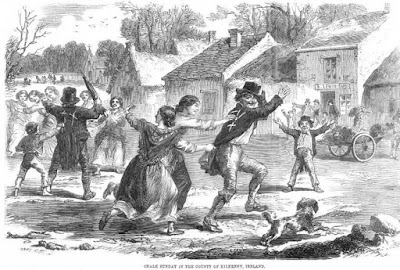Sunday, 21 February 2021
Chalk Sunday
'The first Sunday in Lent is called "Chalk Sunday". It is a very old custom that is followed up to the present day, in almost every parish in the country to chalk the clothes of those who have not married during Shrove, and were in a position to marry.'
Saint Catherine's Monastery
THE ARK IN THE WILDERNESS
Saint Catherine's Monastery as a Unesco Heritage Site:
Criterion (i): The architecture of St Catherine's Monastery, the artistic treasures that it houses, and its domestic integration into a rugged landscape combine to make it an outstanding example of human creative genius.
Criterion (iii): St Catherine's Monastery is one of the very early outstanding examples in Eastern tradition of a Christian monastic settlement located in a remote area. It demonstrates an intimate relationship between natural grandeur and spiritual commitment.
Criterion (iv): Ascetic monasticism in remote areas prevailed in the early Christian church and resulted in the establishment of monastic communities in remote places. St Catherine's Monastery is one of the earliest of these and the oldest to have survived intact, being used for its initial function without interruption since the 6th century.
Criterion (vi): The St Catherine’s area, centred on the holy mountain of Mount Sinaï (Jebel Musa, Mount Horeb), like the Old City of Jerusalem, is sacred to three world religions: Christianity, Islam, and Judaism.
-------------------------------------------------
Interesting facts about Saint Catherine’s Monastery:
Saint Catherine’s Monastery lies on the Sinai Peninsula in Egypt, at the mouth of a gorge at the foot of Mount Sinai.
Although it is commonly known as Saint Catherine’s, the monastery’s full official name is the Sacred Monastery of the God-Trodden Mount Sinai.
Built between 548 and 565, the monastery is one of the oldest working Christian monasteries in the world.
The monastery was built by order of the Eastern Roman Emperor Justinian I at the site where Moses [according to tradition saw] the burning bush.
The architecture of St Catherine’s Monastery, the artistic treasures that it houses, and its domestic integration into a rugged landscape combine to make it an outstanding example of human creative genius.
St. Catherine’s Monastery is surrounded on all sides by a massive wall 2.5 meters (8,2 feet) wide and 11 meters (36 feet) high. It is made of huge dressed granite blocks except for the upper sections, which were restored on orders of Napoleon using smaller, undressed stone blocks. Christian symbols, such as crosses and monograms, are carved on the wall in various places.
The monastery has never been destroyed in all its history, and thus it can be said to have preserved intact the distinctive qualities of its Greek and Roman heritage.
Members of other Christian confessions have honoured the monastery, coming as pilgrims to this holy place. But from its beginnings, the Christian inhabitants of Sinai belonged to the Greek speaking world, and it has remained so to this day.
According to tradition, Catherine of Alexandria was a Christian martyr sentenced to death on the wheel. When this failed to kill her, she was beheaded. According to tradition, angels took her remains to Mount Sinai. Around the year 800, monks from the Sinai Monastery found her remains.
The main church of the monastery is the Church of St. Catherine , which was built of granite by the Byzantine architect Stephen of Aila at the same time as the defensive walls. The church structure, the roof, and the carved cedar doors at the entrance are all originals from 527 AD.
Inside, the church has a broad main nave, two side aisles, an apse and a narthex. The nave is bordered by massive granite columns with capitals decorated with Christian symbols. Each aisle has three chapels and there is a chapel on each side of the apse.
The iconostasis dates to 1612 and was made in the Monastery’s dependency of Crete at the time of Archbishop Lavrentios. ...
The monastery has been honoured by rulers throughout its history. These include the Empress Helena, the Emperor Justinian, Mohammed the Founder of Islam, Sultan Selim I, the Empress Catherine of Russia, and Napoleon Bonaparte.
The monastery is controlled by the autocephalous Church of Sinai, part of the wider Eastern Orthodox Church, and is a UNESCO World Heritage Site.
Sunday, 14 February 2021
Sunday, 7 February 2021
A 300-year-old library tool
that enabled a researcher to have seven books open at once (located at Biblioteca Palafoxiana in Puebla, Mexico)
Subscribe to:
Comments (Atom)













